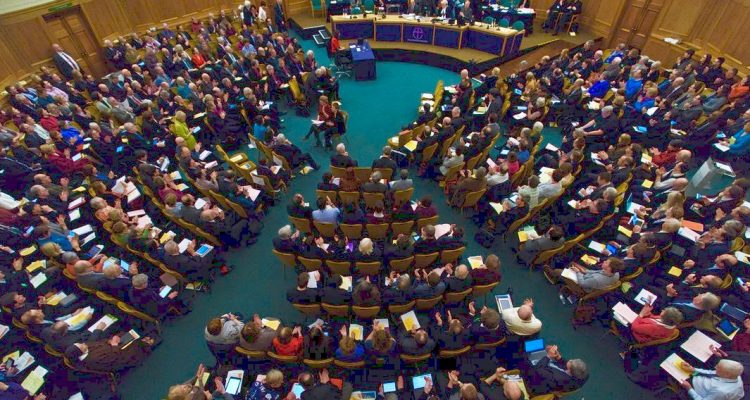 By Zachary Guiliano
By Zachary Guiliano
General Synod’s most significant morning business Feb. 14 concerned the reading of banns in parish churches, along with other administrative duties performed by “clerks in Holy Orders.”
Parish priests have fulfilled some of these requirements since they were first mandated at the Second Lateran Council in 1215, both to ensure the church’s canon law on marriage impediments was properly observed and to prevent clandestine marriages. Further legislation on banns emerged in the Roman Catholic Church at the Council of Trent, and in the Church of England after the 1753 Hardwick Act.
The Rev. Stephen Trott (Peterborough) introduced a motion inviting the “Archbishops’ Council to bring forward draft legislation to replace ecclesiastical preliminaries to marriage by universal civil preliminaries.” Trott said in his speech on the motion that he has “always been uneasy about banns,” and thinks that they are not appropriate to the demands of 2017, especially since other sorts of legal requirements have been added to them. He noted the current need to check the passports of couples. The reading of banns “no longer does what it says on the tin. It is not an effective means of enquiry.”
The discussion has been complicated by some pre-Synod intervention. William Nye, secretary general of the Synod, had weighed in with a document that argued the C of E had much to lose by changing its rules on marriage: not least, contact with numerous couples and a source of revenue at about £2 million in fees each year.
The debate that followed was wide-ranging, with members of Synod bringing up points of legislative history from the Middle Ages to the modern period, raising the question of the relation of church and state, and asking questions about missional effectiveness.
Mike Todd (Truro) argued that church and state have “very different interests” in marriage, with the state’s focus being on property, pension rights, welfare, and other similar matters, while the church is concerned with enacting “God’s grace” in the life of the couple.
Todd cited his recent PhD thesis on marriage to back a series of claims about legislative history, saying that the church has been “shackled” to the state on this question. Disentangling the church from the state’s requirements would allow members of the C of E to “define for ourselves the boundaries of marriage,” he said. “Loosed from being the agent of the state,” the church could “help people find God’s grace” throughout their marriage, not just at the beginning.
In contrast, Prudence Dailey (Oxford) said: “If we believe in Establishment, which I think most of us do, and the Church of England certainly does, let’s not forever be trying to unpick the ties between church and state.” The reading of banns has “symbolic value” beyond the “immediate trappings of administration.” If the C of E was to be “the church for the nation,” banns should not be undone.
Members of Synod disagreed sharply on whether banns and marriage administration presented a missional opportunity or a burden preventing clergy from more significant work.
The Rev. Kate Stacy (Oxford) said that current processes put priests in contact with “500,000 people” they might not otherwise see. She also noted her surprise that the evangelistic role of “occasional offices” like marriage seem “bafflingly absent from Reform and Renewal rhetoric.”
The Ven. Cherry Vann (Manchester), prolocutor the Lower House of the Convocation of York, noted that the processes put clergy directly in touch with a great number of 18- to 45-year-olds, “the very group” absent from many churches.
Others told significant stories about how marriage preparation or the process of reading banns led key members of their congregations to become involved in the first place. The Rev. Sally Lodge (Chelmsford) introduced Synod members to woman she called Paula. After telling her story, she declared: The burden of marriage administration is “a burden worth bearing for the Paulas of this world.”
On the other hand, speakers like the Rev. Tiffer Robinson (Edmundsbury & Ipswish) claimed that people found the process “bizarre” and off-putting.
For these reasons, among others, the Rev. Neil Patterson (Hereford) moved an amendment that he thought “would greatly [simplify] the current system of ecclesiastical preliminiaries in order to reduce the administrative burden on clergy whilst retaining so far as possible the ‘one-stop-shop’ and pastoral benefits of the local arrangement of marriages.”
He offered perhaps the most colorful phrase of the morning, arguing that some clergy in favor of the current system might suffer from a certain sort of romanticism. “Afficionados” of ecclesiastical law might enjoy the thought that the Archbishop of Canterbury, in special cases, exercises powers formerly enjoyed by papal legatines — that the swollen body “of Cardinal [Thomas] Wolsey” lurks “under the trim figure” of Justin Welby.
More seriously, he said, the current process “perpetuates the illusion we have about ourselves: that we own marriage, that we control marriage, that we permit marriage to those we consider worthy.” This illusion adds to the painfulness of other debates about sexuality.
As the vote on the amendment was taken, it turned out to be too close to call. The chair called members to resort to “their gadgets” for voting. After a pause, the vote took place and, to considerable gasps, the amendment was narrowly defeated.
As the final vote on the motion came up, the Synod decided to vote by Houses, since the matter touched on “the rights and duties of the clergy.” The motion was, in the end, defeated narrowly in all three Houses.
This loss was significant.
But the voting revealed something else: only 26 bishops were present, although more than 50 have the right to vote. Perhaps the real question is this: While a significant debate on marriage banns took place, what were the bishops doing?









